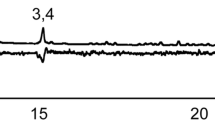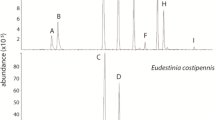Abstract
An investigation to identify a sex or aggregation pheromone of Sitona discoideus Gyllenhål (Coleoptera: Curculionidae) is presented. Antenna flicking and attraction behaviors evoked by conspecifics of both sexes were recorded in arena bioassays, where attraction of females to males was observed. Air entrainment of both males and females was conducted in separate chambers. Gas chromatographic–mass spectrometric analysis of headspace volatiles revealed that two male-specific compounds, 4-methyl-3,5-heptanedione (major) and (4S,5S)-5-hydroxy-4-methyl-3-heptanone (minor), were emitted during the autumnal post-aestivatory flight period. The stereoisomers of the minor component were separated by enantioselective gas chromatography and their absolute configurations assigned by NMR (diastereomers) and the known preference of enantioselective transesterification reactions catalyzed by Candida antarctica lipase B. Electroantennogram and single sensillum recording studies indicate that 4-methyl-3,5-heptanedione as well as all individual stereoisomers of 5-hydroxy-4-methyl-3-heptanone are detected by the antennae of male and female S. discoideus. Further, single sensillum recordings suggest that both sexes of S. discoideus have specialized olfactory receptor neurons (ORNs) for detecting 4-methyl-3,5-heptanedione and different populations of stereoselective ORNs for detecting the stereoisomers of 5-hydroxy-4-methyl-3-heptanone. Some of these stereoselective ORNs appear to be sex-specific in S. discoideus.









Similar content being viewed by others
References
Baker TC (1985) Chemical control of behaviour. In: Kerkut GA, Gilbert LS (eds) Comprehensive insect physiology, biochemistry and pharmacology. Pergamon Press, Ltd, Oxford, pp 621–672
Blight MM, Pickett JA et al (1984) An aggregation pheromone of Sitona lineatus: identification and initial field studies. Naturwissenschaften 71(9):480–480. doi:10.1007/bf00455905
Blight MM, Dawson GW, Pickett JA, Wadhams LJ (1991) The identification and biological activity of the aggregation pheromone of Sitona lineatus. Asp Appl Biol 27:137–142
Bohman B, Unelius CR (2009) Synthesis of all four stereoisomers of 5-hydroxy-4-methyl-3-heptanone using plants and oyster mushrooms. Tetrahedron 65(42):8697–8701. doi:10.1016/j.tet.2009.08.049
Chadwick CE (1960) Sitona humeralis Steph. (Coleoptera: Curculionidae) recorded from New South Wales. Aust J Sci 22:453–455
Esson MJ (1975) Notes on the biology and distribution of three recently discovered exotic weevil pests in Hawkes Bay. Proceedings of the 28th New Zealand Weed and Pest Control Conference. pp. 1208–1212
Frampton ER (1987) The reproductive seasonality and flight capability of Sitona discoideus Gyllenhal (Coleoptera: Curculionidae) and its pattern of larval establishment in Canterbury lucerne. PhD, University of Canterbury
Goldson SL, French RA (1983) Age-related susceptibility of lucerne to sitona weevil, Sitona discoideus Gyllenhal (Coleoptera: Curculionidae), larvae and the associated patterns of adult infestation. N Z J Agric Res 26(2):251–255
Goldson SL, Frampton ER et al (1984) The seasonal biology of Sitona discoideus Gyllenhal (Coleoptera: Curculionidae), an introduced pest of New Zealand lucerne. Bull Entomol Res 74(02):249–259. doi:10.1017/S000748530001138X
Goldson SL, Dyson CB et al (1985) The effect of Sitona discoideus Gyllenhal (Coleoptera: Curculionidae) on lucerne yields in New Zealand. Bull Entomol Res 75(03):429–442. doi:10.1017/S000748530001453X
Goldson SL, Proffitt JR et al (1990) Seasonal biology and ecology in New Zealand of Microctonus aethiopoides (Hymenoptera: Braconidae), a parasitoid of Sitona spp. (Coleoptera: Curculionidae), with special emphasis on atypical behavior. J Appl Ecol 27:703–722
Heathcock CH, Pirrung MC et al (1979) Acyclic stereoselection. 4. Assignment of stereostructure to β-hydroxycarbonyl compounds by carbon-13 nuclear magnetic resonance. J Org Chem 44(24):4294–4299
Kain WM, Trough TRE (1982) Insect pests of lucerne in New Zealand. In: Wynn-Williams RB (ed) Lucerne for the 80s. (Special Publication No.1). Agronomy Society of New Zealand Christchurch, New Zealand, pp 49–57
Kazlauskas RJ, Weissfloch ANE et al (1991) A rule to predict which enantiomer of a secondary alcohol reacts faster in reactions catalyzed by cholesterol esterase, lipase from Pseudomonas cepacia, and lipase from Candida rugosa. J Org Chem 56(8):2656–2665. doi:10.1021/jo00008a016
Landon F, Ferary S et al (1997) Sitona lineatus host-plant odors and their components: effect on locomotor behavior and peripheral sensitivity variations. J Chem Ecol 23:2161–2173
Mori K, Ebata T (1986) Pheromone synthesis. 88. Synthesis of all of the four possible stereoisomers of 5-hydroxy-4-methyl-3-heptanone (sitophilure), the aggregation pheromone of the rice weevil and the maize weevil. Tetrahedron 42(16):4421–4426
Mori K, Yoshimura T et al (1988) Pheromone synthesis. CX. Synthesis of (4S,5R)-5-hydroxy-4-methyl-3-heptanone (sitophilure), the aggregation pheromone of Sitophilus oryzae and S. zeamais. Liebigs Ann Chem 9:899–902
Nielsen BS, Jensen TS (1993) Spring dispersal of Sitona lineatus: the use of aggregation pheromone traps for monitoring. Entomol Exp Appl 66(1):21–30. doi:10.1111/j.1570-7458.1993.tb00688.x
Schmuff NR, Phillips JK et al (1984) The chemical identification of the rice weevil and maize weevil aggregation pheromone. Tetrahedron Lett 25(15):1533–1534
Toth M, Smart LE, Szarukan I, Imrei Z (1998) Preliminary observations on species specificity of Sitona lineatus (L.) pheromone traps in Hungary (Coleoptera: Curculionidae). Acta Phytopathol Entomol Hung 33(3–4):349–356
Unelius CR, Sandell J et al (1998) Enantioselective preparation of the stereoisomers of 4-methylheptan-3-ol using Candida antarctica Lipase B. Collect Czechoslov Chem Commun 63(4):525–533
Walgenbach CA, Burkholder WE (1986) Factors affecting the response of the maize weevil, Sitophilus zeamais (Coleoptera: Curculionidae), to its aggregation pheromone. Environ Entomol 15(3):733–738
Walgenbach CA, Phillips JK et al (1987) Determination of chirality in 5-hydroxy-4-methyl-3-heptanone, the aggregation pheromone of Sitophilus oryzae (L.) and S. zeamais Motschulsky. J Chem Ecol 13(12):2159–2169
Acknowledgments
We thank B. J. Bunn for synthesis of 4-methyl-3,5-heptanedione and J. Daly and A. R. Gibb for their assistance in the initial studies. This research was funded by the Ministry of Building Innovation and Employment through the Bio-Protection Research Centre (LINX0304, contract 25949). The Linnaeus University, Kalmar, Sweden, is gratefully acknowledged for financial support of BB and CRU.
Author information
Authors and Affiliations
Corresponding author
Additional information
Communicated by: Sven Thatje
Electronic supplementary material
Below is the link to the electronic supplementary material.
ESM 1
(DOCX 34 kb)
Rights and permissions
About this article
Cite this article
Unelius, C.R., Park, KC., McNeill, M. et al. Identification and electrophysiological studies of (4S,5S)-5-hydroxy-4-methyl-3-heptanone and 4-methyl-3,5-heptanedione in male lucerne weevils. Naturwissenschaften 100, 135–143 (2013). https://doi.org/10.1007/s00114-012-1003-4
Received:
Revised:
Accepted:
Published:
Issue Date:
DOI: https://doi.org/10.1007/s00114-012-1003-4




